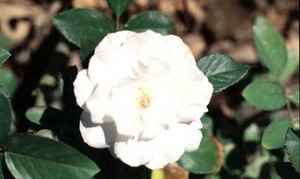Although I didn’t get to spend as much time with my great grandmother on my grandfather’s side, I do remember how warm and comforting her arms felt around me. I also remember the sound of her voice, so low and fraught with emotion, whenever she spoke of her people – – the Cherokee Indians.
She was just a baby when the Cherokee were forced to move into the southwestern portion of our country. She didn’t even remember her original home although she thought it had been located somewhere in Virginia. Her father died just after the journey began and her mother died just a few years after they reached Oklahoma.
Taken in by friends who did their best to recall some family history for her, in truth they had not known her parents long enough to deliver a full background. They did, however, tell her many stories about their journey along what would become known as “The Trail of Tears” as well as the legend of the Cherokee rose.
My great grandmother’s family, along with thousands of Native Americans, were living in northwestern Georgia when gold was discovered there. In 1838 they were pushed even further west so that the “white man” could mine the territory. Their journey became known as the “Trail of Tears” because so many people endured hardships and died along the way.
By this time, the Cherokee people had almost lost hope. Many brave warriors were reduced to be slaves to the soldiers that guarded them in order to earn pitiful sums of money or supplies to feed their children. The women cried constantly. They cried for their departed ancestors, their husbands, and their dying children. Most of them believed that they would die before the reached the end of their journey.
The Cherokee, like most Native American tribes, were very spiritual people. They believed that if they lived in balance with nature, she would always care for them. But through no fault of their own, that balance had been tipped out of their control. Therefore, they lost faith that they might be saved.
The elders of the seven Cherokee clans decided that they had to provide some sign of hope so that at least their children and their children’s children might live to continue the Cherokee line. So they got together as a group and prayed as one voice to the Great One, asking for a small sign of hope that might sustain their people.
At first, they thought their prayers had been ignored, but then they began to notice a peculiar thing happening along the pathway of their journey. Everywhere a mother’s tears dropped to the earth, a beautiful plant would grow. From the plant sprung beautiful white roses.
Ecstatic that their prayers had been answered, the elders took time to thank the Great One for his gift. Whether or not it was he that explained the significance of the plant to the people or if they came up with it themselves is unclear. However, it was explained to me this way:
The rose was white to represent the purity of the Cherokee heart. The gold in the center of the flower represented the white man’s greed for gold that had, once again, supplanted the Cherokee people from their land. The leaves came in groups of seven to represent the seven clans of Cherokee.
The plant was hearty and grew rapidly along the “Trail of Tears” to mark the lonely and terrifying journey taken by the Cherokee people. It had brambles to protect it from being pulled out by those who wished to destroy it and all that it signified. But, like the Cherokee people themselves, it would not be destroyed. It continues to grow along the route to this very day.
More than one-fourth of the Cherokee people died on the road to Oklahoma. The journey was no doubt also responsible for the early deaths of my great great great grandparents. However, my grandmother grew up brave and strong, eventually meeting and marrying the man would help bring my beloved grandfather to me.
I wish I could remember more of the stories that my grandmother shared about “The Trail of Tears.” I do remember that she spoke reverently about the people who survived the journey and eventually established the Cherokee Nation in Oklahoma. She was proud of her heritage and she made me proud to have a piece of it within me.
The white rose was my great grandmother’s favorite flower. She felt that it spoke to her of family, pride, strength, courage, and hope. It has become one of my favorite flowers as well because when I see when I cannot help by recall the legend of the Cherokee rose.




